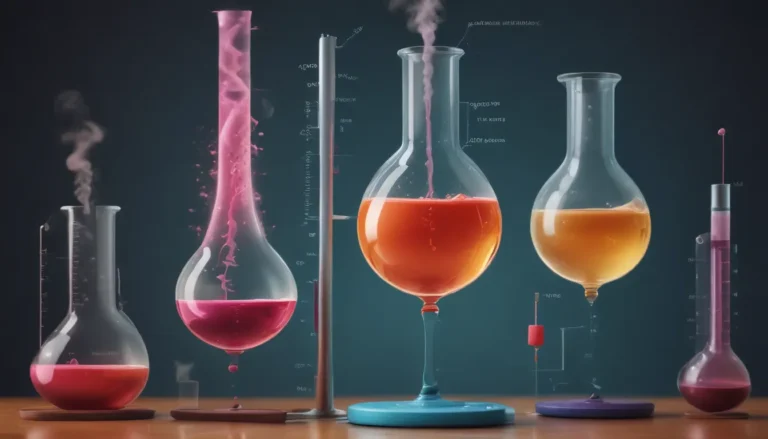A Note About Images: The images used in our articles are for illustration purposes only and may not exactly match the content. They are meant to engage readers, but the text should be relied upon for accurate information.
Welcome to the captivating world of molarity, a fundamental concept in chemistry that plays a crucial role in various scientific endeavors. Whether you are a student, a researcher, or simply curious about the world of science, understanding molarity is essential for unlocking deeper insights into chemical reactions and solutions. In this article, we will explore 12 fascinating facts about molarity that will enhance your understanding of this concept and its significance in the field of chemistry.
Unraveling the Mysteries of Molarity
Molarity, denoted by the symbol “M,” is defined as the concentration of a solute in a solution, expressed as the number of moles of solute per liter of solution. This metric is essential for chemical calculations and laboratory experiments, providing valuable insights into the composition and properties of solutions.
Calculating Molarity: A Simple Formula
Calculating molarity is a straightforward process that involves dividing the number of moles of solute by the volume of the solution in liters. The formula for molarity is as follows: Molarity = Moles of Solute / Volume of Solution. By applying this equation, scientists can determine the molarity of a solution and make accurate predictions in chemical reactions.
The Role of Molarity in Dilutions
Molarity plays a crucial role in dilution calculations, allowing scientists to determine the new molarity of a solution when it is diluted by adding a solvent. By understanding the initial molarity and volume of the solution, researchers can accurately adjust the concentration of the solution to meet specific requirements.
Molarity and Stoichiometry: A Perfect Match
In stoichiometry, the branch of chemistry that deals with the quantitative relationships between reactants and products in chemical reactions, molarity is a vital tool. It enables scientists to determine the precise amount of reactants required for a reaction based on the desired molarity of the products, ensuring efficient and accurate experimental outcomes.
Exploring Units of Molarity
Molarity is typically expressed in mol/L, representing the number of moles of solute per liter of solution. However, alternative units such as millimolar (mM) or micromolar (M) can be used depending on the concentration of the solution. Understanding these units is essential for interpreting molarity values in diverse contexts.
Unveiling the Standard Molarity Solution
A standard molarity solution, also known as a “standard solution,” serves as a reference point for determining the unknown molarity of other solutions. This type of solution is essential for titrations and calibration purposes, providing researchers with a reliable benchmark for quantitative analysis.
Molarity’s Influence on pH and Solubility
Molarity plays a crucial role in determining the pH of a solution, particularly in the context of acids and bases where the concentration of H+ or OH- ions influences the acidity or alkalinity of the solution. Additionally, molarity is closely related to the solubility of a solute in a solvent, defining the maximum amount of solute that can be dissolved under specific conditions.
Molarity’s Impact on Biological Systems
In biological systems, molarity is indispensable for describing the concentration of ions and molecules critical to various processes. From osmosis and enzyme kinetics to drug interactions, molarity provides valuable insights into the intricate mechanisms that govern biological functions, highlighting its significance in the field of biology.
Embracing Serial Dilutions
Serial dilutions, characterized by a series of dilutions using the same factor, are commonly employed in laboratory experiments to achieve desired concentrations. Molarity calculations play a pivotal role in ensuring the accuracy and precision of each step in the dilution series, underscoring the importance of molarity in experimental settings.
Discovering the Beer-Lambert Law
In spectroscopy, the Beer-Lambert Law establishes a relationship between the concentration (molarity) of a solute in a solution and the absorption of light. This fundamental law provides a foundation for determining the concentration of unknown substances in solutions, offering valuable insights into quantitative analysis and spectroscopic techniques.
Real-Life Applications of Molarity
Molarity finds widespread applications in real-life scenarios, ranging from pharmaceutical formulations and environmental analysis to the food and beverage industry and medical diagnostics. As a critical tool for quality control and precise measurements, molarity plays a pivotal role in ensuring the safety, efficacy, and reliability of various products and processes.
A Vibrant Conclusion
In conclusion, the concept of molarity is not only essential for mastering chemical calculations but also for conducting successful experiments and analyses in the realm of chemistry. By delving into the intriguing world of molarity and exploring its multifaceted applications, we gain a deeper appreciation for the role this concept plays in shaping our understanding of the natural world.
FAQs: Exploring Common Questions
- What is molarity, and how is it defined?
Molarity is a measure of the concentration of a solute in a solution, expressed as the number of moles of solute per liter of solution.
- How is molarity calculated, and what is the formula?
Molarity is calculated by dividing the number of moles of solute by the volume of the solution in liters. The formula for molarity is Molarity = Moles of Solute / Volume of Solution.
- What are some common units used for molarity?
The most common unit for molarity is “moles per liter” (mol/L or M), but other units such as millimoles per liter (mmol/L) or micromoles per liter (µmol/L) can also be used.
- Why is molarity important in chemical reactions?
Molarity plays a crucial role in determining the amount of reactants needed for a chemical reaction, as well as calculating reaction rates and understanding the relationship between concentration and the rate of reaction.
- Can molarity change with temperature?
Yes, molarity can change with temperature due to changes in the volume of a liquid. It is important to consider temperature effects when working with molarity calculations.
- How does molarity differ from molality?
Molarity measures the concentration of a solute in a solution, while molality measures the concentration of a solute in a solvent. Molarity considers the volume of the solution, whereas molality considers the mass of the solvent.
- What are some practical applications of molarity in real life?
Molarity is applied in various fields such as pharmaceuticals, environmental analysis, and food and beverage production. It aids in determining medicine dosages, monitoring pollutants in water, and maintaining desired concentrations in food and beverage processes.
Intriguing and insightful, molarity offers a doorway into the intricate world of chemistry, inviting learners to explore and expand their knowledge. By embracing the foundational principles of molarity and uncovering its diverse applications, we gain a deeper understanding of the profound impact this concept has on scientific discovery and innovation. As we continue to unravel the mysteries of molarity, we embark on a journey of discovery and growth, fueled by curiosity and a passion for knowledge.






